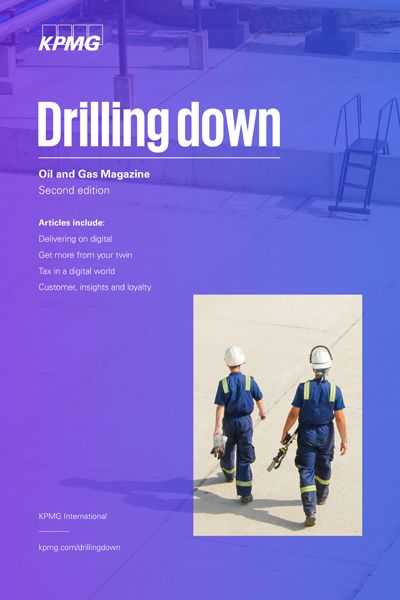As tax moves higher up the agenda for oil and gas companies, the need for a digital tax transformation is becoming more critical. Here’s how oil and gas finance and tax leaders can transform their tax function to transform value.
The big disruptor: Tax moves up the Oil & Gas agenda
The OECD isn’t your typical disruptor, nor are most tax authorities. But, over the past few years, tax authorities, governments, and Non-Governmental Organizations (NGOs) have radically changed the corporate tax environment. The impact has been disruptive – particularly to the oil and gas sector.
The OECD’s progress on Base Erosion and Profit Shifting (BEPS) and Pillar 2.0, for example, introduces a global framework to ensure large multinational enterprises pay a Global Minimum Tax of 15 percent on the income arising in each jurisdiction where they operate. This is disrupting many a company’s strategic tax planning with a heightened focus on digital tax transformation.
At the same time, tax authorities are also becoming more proactive. Tax authorities reach into taxpayers’ invoicing systems in many markets and determine indirect taxes in real-time. Many are already exploring how they might similarly reach into a company’s Enterprise Resource Planning (ERP) system to conduct automated tax reviews, assessments and audits. And they are starting to think about how they would want taxpayer data to be organized to make that process easier for them.
Many governments are using tax as both a Big Stick and a Big Carrot to help accelerate their energy transition and climate agendas. That has led to a complex array of new taxes, incentives and credits in virtually every market around the world. The slew of new measures announced in the US Inflation Reduction Act serves as a case in point. And remember that all countries and territories offer different regimes. Navigating the complexity and options is challenging.
The challenge for oil and gas leaders is that all of this tax disruption is coming at a time of massive strategic and business model disruption – including the most significant business disruptor of all, the ESG agenda. Tax touches all pillars of the ESG agenda. Oil and gas players are diversifying into new lines of business, growing their downstream capabilities and investing in adjacencies (like renewables) and entirely new business models (like the metaverse). The tax implications will be tremendous.
Responding to all of this change in the tax environment (and, most importantly, ensuring compliance) will require a massive shift in how oil and gas companies currently manage their tax function. There is bound to be more disruption.
A closer look at the US Inflation Reduction Act
The Inflation Reduction Act includes a wide range of different tax incentives and benefits, including a robust package of energy and climate related provisions. It is notable not only for the numerous new energy tax incentives it provides but also for the number of new mechanisms employed to deliver these incentives.
In some instances, the new law provides for direct payments from the federal government to taxpayers (if they don’t offset income). In other cases, the tax credits can be transferred or sold to other taxpayers. Together, these new mechanisms require taxpayers and the IRS to think differently about long-held concepts of the US system.
The urgent need for tax transformation
As tax moves up the agenda, the tax function is becoming more visible at the decision-making table. Oil and gas executives are increasingly looking to their tax leaders to be more strategic. They want to see various tax scenarios as they plan their business strategy. They expect their tax leaders to bring them ideas and opportunities to help drive growth. They want to know their tax professionals are on top of changes in the international tax environment. They want their tax professionals to protect the tax reputation of their organization.
Like other parts of the business, tax is under pressure to move faster and with more agility. Tax professionals are being asked to cover more ground – they need to understand the nuances of ESG reporting, the impact of digital taxes and the complexities of retail taxes, for example. They also need to be increasingly efficient, effective and capable in their compliance and reporting activities. Yet few are seeing a commensurate increase in budgets or headcounts to handle the expanded scope. And this type of Do-More-With-Less mantra does little to inspire transformation.
This is at a time when the urgency of tax transformation is becoming critical. Generally speaking, tax technology infrastructure at most oil and gas companies is due for an overhaul. Excel spreadsheets are everywhere. Data from different ERP systems don’t always correlate. A recent survey by KPMG International finds that 64 percent of Chief Technology Officers say their tax personnel spend more time data collecting and getting data ready than performing tax analytics.[1] Even when tax data is available, only some organizations use it strategically.
Most oil and gas tax functions now find themselves at a pinch point. The business expects them to be more strategic, efficient and capable. But tax functions need more technology tools, capability and capacity to deliver on those expectations. Digital transformation is the only solution.
Digital transformation offers tax functions a clear path to strategic value delivery. It allows existing processes to be re-engineered with fewer manual touchpoints and greater agility. It introduces self-service functions, automation and machine learning, freeing human resources for more strategic and value-adding tasks. It offers opportunities to ‘tax sensitize’ data across siloes to deliver a single source of the truth. It creates room for new operating and sourcing models.
Digital transformation can enable oil and gas tax functions to automate the manual and repetitive, offload the tactical, take on the strategic, and deliver real value. There are a few other options given the expectations for the tax function going forward.
Where are tax functions investing?
According to KPMG’s annual benchmark survey of energy, power and utilities tax leaders, 88 percent of tax functions plan to increase their investment in tax-specific technologies. Three-quarters plan to increase their use of enterprise finance IT systems for tax purposes. When asked where they would put an extra dollar of investment if they had it, most frequently, they said they would invest in tax technology.
Data will drive the agenda
The drivers of digital transformation for the tax function are everywhere – greater demand from the business, rapidly changing regulations, heightened tax authority expectations, efficiency objectives, talent shortages – the list goes on. But we expect what will ultimately force tax functions to transform will be the need for more reliable and accessible real-time data.
The following 18 months will see tax functions looking for – and being asked for – increasing amounts of data. Internally, the pressure for more forward-looking tax scenarios and insights is forcing tax leaders to reassess the freshness and accessibility of their data. They want to provide the business with accurate and strategic forecasts, but they can’t always trust the data they receive from multiple systems.
Consider the data requirements for applying for various sustainability-linked tax credits and incentives. That will require tax functions to access new data sources that may or may not currently exist. Where it is available, it is likely spread across various processes, systems and assets in different formats and degrees of completeness and transparency. Some of it may need to be lifted from third-party service providers or Joint Ventures.
The external pressure for better and more frequent data is also pushing tax functions to a crisis point. Tax authorities are moving towards real-time tax reporting, requiring tax functions to be much more confident about their data. At the same time, stakeholders and investors are pushing for greater tax transparency as part of the ESG agenda (14 percent of energy sector tax functions say they already publicly disclose their tax information, and 32 percent say they plan to in the future).[2]
Perhaps not surprisingly, tax leaders say they will need to manage their data better if they want to operate effectively in the new normal. Almost eight-in-ten say they will require data management, extract, load and transformation (ETL) tools, and 60 percent say they need ERP, source systems and data warehouses to operate more effectively.[3]
The data also suggests that tax leaders are currently working to standardize their processes and implement new technology tools to lessen the burden of data management on their function.[4]
Over the next 18 months, the demand for data will become a clarion call for tax and business leaders in the oil and gas sector to invest in digital tax transformation.

Six Steps towards a data-driven tax function
1. Start with a standard data model:
In our experience, sustainable transformation can’t happen until the tax function has developed standardized, integrated processes and common data models—a way to organize data from many sources and formats into a standard structure and share it seamlessly between different systems, applications and resources. The good news is that various technologies can help tax functions solve data issues that hamper transformation efforts.
2. Capitalize on ERP upgrades:
ERP investments are increasing as organizations work to comply with evolving financial reporting rules and requirements. A new ERP rollout or upgrade is an excellent chance for tax functions to optimize data and processes by adding clear tax specifications to work with the latest business systems. Meanwhile, prominent enterprise vendors are moving to cloud platforms, which creates additional opportunities for tax functions to access and integrate the data they need and design tax-sensitized solutions faster and cheaper.
3. Empower ESG with data and analytics (D&A):
Tax and ESG are converging, with corporations being asked to publicly share more information on their tax strategy and operating model, going beyond mandatory disclosure requirements. Predictive and scenario modeling enables enterprises to make decisions that align with the tax strategy while meeting calls for enhanced tax transparency and reporting under ESG. Next-level and real-time data analysis will enhance tax modeling and planning in this new, complex environment.
4. Embrace intelligent automation:
As tax functions come under pressure to reduce costs, the focus of technology spending is shifting toward emerging technologies. Intelligent automation offers powerful benefits for tax functions facing new responsibilities and compliance demands, helping save time and costs and allowing tax professionals to focus on higher-level strategic activities. By embedding intelligent automation capabilities such as enhanced vision, speech, and language, tax functions can bridge gaps between systems and mimic manual steps executed by humans.
5. Explore managed services:
Data management and transformation as a service is an emerging need in tax, specifically for virtual collaboration and operation of multinational companies in the global environment. This allows tax functions to unbundle different parts of processes, keeping only the most value-added data analysis activities in-house. Skilled tax professionals can then focus on what they were trained to do – analyzing data and deriving tax insights.
6. Transform with people in mind:
Tax leaders should not underestimate the necessity of change in other areas of operations, including people, roles and responsibilities, culture, and service delivery. It comes down to this: More than a new tool or dashboard is needed to evolve the tax function into a more strategic business partner. Tax departments that are intentional, systematic and holistic in their approach to technology and data investments will see actual results.

Overcoming the barriers
Securing investment capital and permission to redesign and transform the tax function is not easy and will take work. Tax and finance leaders will need to put significant effort into moving this up the investment agenda for the organization.
Start by focusing on small wins that demonstrate considerable value and lead towards a more digital tax operating model. This will partly come down to building the business case for investment. A business case should include quantifiable benefits (such as time savings, cost reduction and energy use), qualitative benefits (like scenario planning capabilities, better forecasting and more strategic advice to the business) and risk mitigation benefits (including financial risk, governance risk or reputational risk).
Education will also be critical. The tax function will need to understand the needs of the business and be able to align its investment requests to specific business outcomes. At the same time, the business will need to gain a greater appreciation for how a more strategic and digitized tax function can benefit the business. Similarly, the tax and technology functions will also need to focus more on internal partnering, to smooth implementation and find opportunities for alignment on investment requests.
At the same time, the increasing dependence on data analytics tools and enterprise systems will require higher technical proficiency at all levels of the tax function. And organizations are competing to attract and retain a limited number of high-skilled tax professionals. One option is to increase the training and upskilling of current tax employees (an activity 58 percent of Chief Tax Officers say they are doing).[5] Another is to look to outsource or co-source some activities (45 percent of CTOs say they rely on outside tax advisers).[6]
Ultimately, building your strategy around a clear vision for a digital tax function is key. If it aligns with the needs of the business and can deliver some quick wins, you should be able to build the right momentum to achieve a real and sustainable tax digital transformation.
Wishlist
Additional personnel and tax technology topped the list for tax leaders when asked where they would invest if they had an additional budget.

Key takeaways
Figure out your vision for tax
Make sure you are aligned with the business and related functions
Build momentum and ROI through quick wins
Look for accelerators and internal partners
Get support from transformation professionals
How KPMG can help
As the world of tax has changed, so have KPMG firms’ services, evolving for the modern complexities and challenges you face to become more multidisciplinary, technology-driven and collaborative. By taking the time to understand your unique business issues, KPMG Tax & Legal professionals can bring you targeted approaches and data-driven insights, engaging a variety of colleagues and service areas from KPMG firms around the world, and often drawing on the experience and knowledge of KPMG specialists in other areas of the organization, including audit and advisory. KPMG professionals are passionate about building trusting, long-lasting business relationships with you―delivering adaptable approaches to deliver the cross-border services that meet your business needs today while helping you transform for tomorrow. United by our values, governed by the KPMG Global Tax Principles, and driven by our purpose to inspire confidence and empower change.
Continue reading Drilling Down #2
Contact our Energy and Tax experts
Connect with us
- Find office locations kpmg.findOfficeLocations
- kpmg.emailUs
- Social media @ KPMG kpmg.socialMedia
Explore
1 KPMG, 2022 Chief Tax Officer Outlook
2 Global Tax Department Benchmarking report, KPMG International, 2021
4 KPMG, 2022 Chief Tax Officer Outlook
5 Ibid
6 KPMG, 2022 Chief Tax Officer Outlook
7 Ibid









